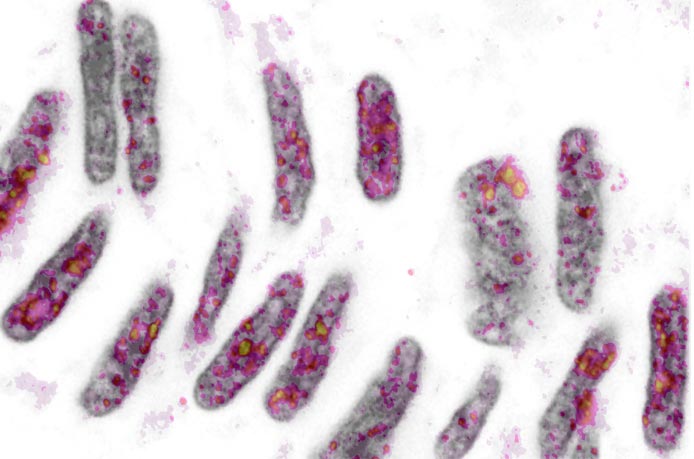A new technique to unravel gene regulation

Zebrafish notochord nuclei at 15-somite stage. Grey: nuclear DNA (DAPI). Color: histone H3K9me3
Credit: Phong Nguyen, Franka Rang & Kim de Luca. Copryight Hubrecht Institute
Learning from the single cell:
How is the activity of genes regulated by the packaging of DNA? To answer this question, a technique to measure both gene expression and DNA packaging at the same time was developed by Franka Rang and Kim de Luca, researchers from the group of Jop Kind (group leader at the Hubrecht Institute and Oncode Investigator). This method, EpiDamID, determines the location of modified proteins around which the DNA is wrapped. It is important to gather information about these modifications, because they influence the accessibility of DNA, thereby affecting the gene activity. EpiDamID is therefore valuable for research into the early development of organisms. The results of the study are published in Molecular Cell on April 1st 2022.
In order to fit DNA into the nucleus of a cell, it is tightly packed around nuclear proteins: histones. Depending on the tightness of this winding, the DNA can be (in)accessible to other proteins. This therefore determines whether the process of gene expression, translation of DNA into RNA and eventually into proteins, can take place.
DNA packaging determine gene activity
The tightness of DNA winding around histones is regulated by the addition of molecular groups, so-called post-translational modifications (PTMs), to the histones. For example, if certain molecules are added to the histones, the DNA winding is loosened. This makes the DNA more accessible for certain proteins and causes the genes in this part of the DNA to become active, or expressed. Furthermore, proteins that are crucial for gene expression can directly recognize and bind the PTMs. This enables transcription: the process of DNA copying.
The regulation of gene expression, for instance through PTMs, is also known as epigenetic regulation. Since all cells in a body have the same DNA, regulation of gene expression is needed to (de)activate specific functions in individual cells. For instance, heart muscle cells have different functions than skin cells, thus require different genes to be expressed.
Analysis of single cells using EpiDamID
To understand how PTMs affect gene expression, first authors Franka Rang and Kim de Luca designed a new method to determine the location of the modifications. Using this approach, called EpiDamID, researchers can analyze single cells, whereas previous methods were only able to measure a large group of cells. Analysis on such a small scale results in knowledge on how DNA winding differs per cell, rather than information on the average DNA winding of many cells.
EpiDamID is based on DamID, a technique which is used to determine the binding location of certain DNA-binding proteins. Using EpiDamID, the binding location of specific PTMs on histone proteins can be detected in single cells. Compared to others, a great advantage of this technique is that researchers need very limited material. Furthermore, EpiDamID can be used in combination with other methods, such as microscopy, to study regulation of gene expression on different levels.
Future prospects
Following the development of this technique, the Kind group will focus on the role of PTMs from the point of view of developmental biology. Because single cells are analyzed using EpiDamID, only a limited amount of material is needed to generate enough data. This allows researchers to study the early development of organisms from its first cell divisions, when the embryo consists of only a few cells.
Publication
Rang, F. J.*, de Luca, K. L.*, de Vries, S. S., Valdes-Quezada, C., Boele, E., Nguyen, P. D., Guerreiro, I., Sato, Y., Kimura, H., Bakkers, J. & Kind, J. Single-cell profiling of transcriptome and histone modifications with EpiDamID. Molecular Cell, 2022.
*Authors contributed equally
Jop Kind is group leader at the Hubrecht Institute for Developmental Biology and Stem Cell Research and Oncode Investigator.
About the Hubrecht Institute
The Hubrecht Institute is a research institute focused on developmental and stem cell biology. It encompasses 21 research groups that perform fundamental and multidisciplinary research, both in healthy systems and disease models. The Hubrecht Institute is a research institute of the Royal Netherlands Academy of Arts and Sciences (KNAW), situated on Utrecht Science Park. Since 2008, the institute is affiliated with the UMC Utrecht, advancing the translation of research to the clinic. The Hubrecht Institute has a partnership with the European Molecular Biology Laboratory (EMBL). For more information, visit http://www.hubrecht.eu.
Journal: Molecular Cell
Method of Research: Experimental study
Subject of Research: Cells
Article Title: Single-cell profiling of transcriptome and histone modifications with EpiDamID
Article Publication Date: 1-Apr-2022
Media Contact
Juliette van Seventer
Hubrecht Institute
j.seventer@hubrecht.eu
All latest news from the category: Life Sciences and Chemistry
Articles and reports from the Life Sciences and chemistry area deal with applied and basic research into modern biology, chemistry and human medicine.
Valuable information can be found on a range of life sciences fields including bacteriology, biochemistry, bionics, bioinformatics, biophysics, biotechnology, genetics, geobotany, human biology, marine biology, microbiology, molecular biology, cellular biology, zoology, bioinorganic chemistry, microchemistry and environmental chemistry.
Newest articles

Economies take off with new airports
A global study by an SUTD researcher in collaboration with scientists from Japan explores the economic benefits of airport investment in emerging economies using nighttime satellite imagery. Be it for…

CAR T–cell immunotherapy targets
Pan-cancer analysis uncovers a new class of promising CAR T–cell immunotherapy targets. Scientists at St. Jude Children’s Research Hospital found 156 potential CAR targets across the brain and solid tumors,…

Stony coral tissue loss disease
… is shifting the ecological balance of Caribbean reefs. The outbreak of a deadly disease called stony coral tissue loss disease is destroying susceptible species of coral in the Caribbean…





















